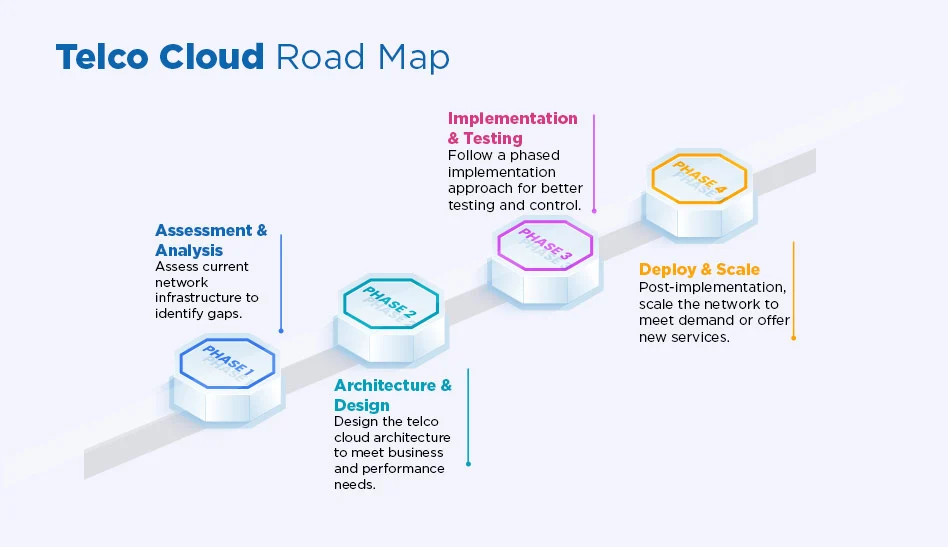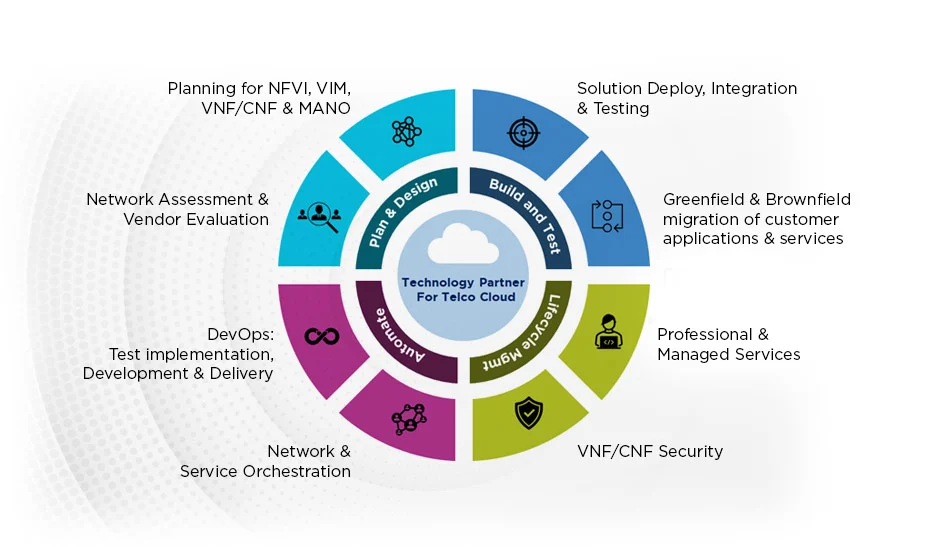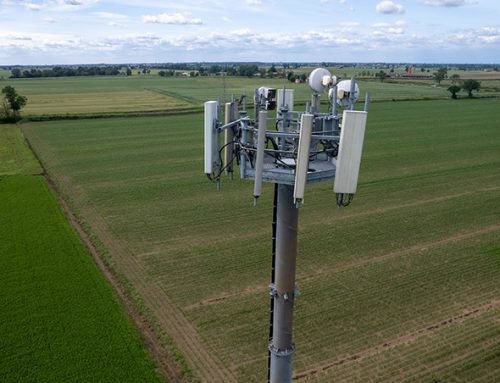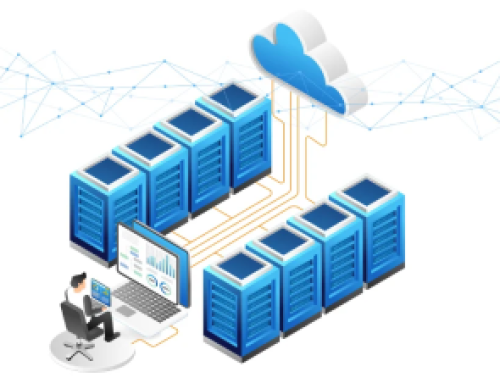Telcos realize the immense impact IT powered next gen technologies like virtualization can bring to their business (check our previous blog – Telco Cloud: A Key Enabler to Telco Transformation). Virtualization, in the form of Network Function Virtualization (NFV), has brought multiple benefits: flexibility, scalability and ease of evolution to telecom networks. But this shift to a virtualized network architecture is complex and there is no easy or quick route.
This transformation requires Communication Service Providers (CSPs) to navigate a complex landscape of technology options, vendor partnerships, regulatory requirements, and customer demands while managing costs and ensuring the quality of service. This blog, part 2 of the 6-part blog series on Telco Cloud, delves into these critical aspects for telco cloud implementation that will help a CSP build a cloud-native network.
Telco Cloud: Why Does it Matter?
When we talk of the cloud, it immediately conjures up images of the IT cloud. While initial impressions suggest the telco cloud resembles an ordinary IT cloud, instead, the telco cloud is highly specialized. It caters to a telco-grade network’s demand for low latency, high availability, and strict Quality of Service (QoS) guarantees. It is designed and optimized to manage network-specific requirements including scalability, security, reliability, and service orchestration making it a distinct and telecom industry specific cloud offering.
Challenges Impeding Telco Cloud Adoption
CSPs have large and live networks which run business critical applications. The transformation journey from legacy networks to the telco cloud requires careful planning and execution to ensure network uptime, while preventing business disruption. Additionally, the implementation process is often fraught with uncertainties and challenges such as:
- Legacy Infrastructure: CSPs have invested significant resources in building legacy infrastructure that has evolved over time alongside different technologies and vendors. Migration of such legacy systems can be daunting due to compatibility issues and the sheer complexity of integrating multiple systems.
- Interoperability: A telco cloud can involve multiple cloud platforms across different vendors. Cloud interoperability calls for standardization of interfaces and protocols to ensure that a CSP’s cloud infrastructure collaborates and works efficiently across all the systems. Additionally, it should seamlessly integrate with existing network infrastructure (routers, switches, firewalls) for consistent monitoring, configuration, and control of network resources.
- Network Security: The cloud introduces new potential security risks, especially network related. CSPs must ensure their network infrastructure, applications, and data are secure and meet compliance requirements. Ideally, security should be pre-integrated into the network components of the telco cloud.
- Skills Gap: Specific technical skills – cloud computing, DevOps, and automation are crucial to driving cloud adoption. With the lack of readily available talent pool, CSPs will need to decide whether to build in-house teams or outsource talent.
- Cost: While the long-term benefits of the telco cloud significantly outweigh the costs, cloud migration involves high one-time implementation costs. This includes setting up the cloud components, a governance mechanism, security standards, onboarding and training the talent pool. CSPs may find it difficult to achieve a short-term cost benefit.
Preplan for a Successful Telco Cloud Adoption
The first step in any successful telco cloud transformation is to define a clear strategy that aligns with CSP’s business goals and customer needs. Key considerations should include:
- Prioritize your requirements. Some telcos may focus on scalability and flexibility (e.g., handle a sudden surge in network traffic), while others would prefer to enhance the customer experience (e.g., offer personalized and on-demand services). Other telcos may want to focus on software-defined networking (SDN) capabilities to optimize network resources and improve network efficiency (or to launch new services and enhance existing portfolios). It is critical to identify the core use case before the planning process.
- Identify your partners. Determining the right technology and vendor partnerships is critical to achieve the objectives. Telcos must strike a balance between existing and new OEMs for legacy networks and cloud environment, respectively. A system integrator can play a key role in bringing it all together.
- Check for compliance. Telco cloud implementation will invariably introduce new vendors and APIs across the network as well as the use of open-source architecture. It is critical to ensure requisite security compliance and adherence to additional regulatory and compliance requirements, if any.
The Telco Cloud Roadmap: Four Phases of Adoption
The four stages of the telco cloud roadmap include:
Figure 1: The Telco Cloud Transformation Journey
Phase 1 – Assess the Current Network
Based on the priorities defined in the pre-planning phase, CSPs should assess their current network infrastructure to identify gaps that need to be addressed post-migration. The exercise should include:
- Review existing hardware, software, and network architecture.
- Examine the current traffic patterns and capacity requirements. Map them with customer services.
- Assess and identify legacy systems to be replaced or upgraded. This depends on factors such as flexibility for future upgrades and maintenance costs for the existing systems.
- Identify new hardware and software (VNF, CNF, VNFM, NFVO, and Orchestrator) required to support telco cloud services based on the use case.
- Identify integration requirements with existing and future OSS/BSS and IT stacks.
Phase 2 – Design the Telco Cloud Architecture
The architecture with the right infrastructure and platforms should be governed by the current and future use cases. It will also depend on the type of implementation: a green field, brown field, or hybrid implementation. Additional considerations include:
- Articulating the base system requirements in terms of server performance, storage requirements, and type of networking (e.g., Generic, SR-IOV, DPDK).
- Network functions can be VNFs or CNFs. Choosing the best composition will depend on other telco cloud components: infrastructure, platforms, supports for MPLS packets, support availability for CNF integration, and more.
- Consider the performance and quality of service parameters. Telco cloud workloads or network functions are performance intensive. They need high throughputs and port speeds (up to 100 GB or more), often with 1:1 CPU allocation and oversubscription ratio to maintain an adequate quality of service.
- CSPs should consider peripheral security, and workload security for VNFs and CNFs in line with regional and global security compliance.
Phase 3 – Implement and Test the Telco Cloud
A phased approach to implementation achieves better results. Start with a pilot program in a pre-production environment to evaluate and validate new network infrastructure before going into production.
- Identify different implementation modules (or scenarios) like network function integration, life-cycle management, or service migration for phased introduction.
- Develop use cases for each scenario. Evaluate them against performance, quality, and scalability to mitigate potential issues.
- Monitor the performance of the network functions and services. Onboard a new ecosystem of tools if necessary.
- Ensure interoperability of the telco cloud with other networks and services. For instance, CSPs considering migrating their voice services will need to ensure interoperability with legacy devices such as provider edge, customer premises equipment, routing, load balancing, and security.
Make course corrections based on the output generated in the pre-production environment and replicate the design in the production environment.
Phase 4 – Deploy and Scale the Telco Cloud
Following the successful implementation and testing of the telco cloud, CSPs can launch new services and easily scale the network to meet customer demand while carefully balancing performance, reliability, and cost-effectiveness by:
- Managing capacity planning and resource allocation in the telco cloud.
- Ensuring the scalability and flexibility of the telco cloud to meet changing customer demands.
- Automating service provisioning and management to improve efficiency and reduce costs.
After deployment, it is essential to continuously monitor and optimize the telco cloud for performance and quality of service.
Identifying the Right Partner for the Telco Cloud Journey
The journey to build a cloud native telco may be long but can be alleviated by joining hands with the right technology partner that can correctly guide during the adoption process.
The right technology provider should not only enable a CSP’s cloud journey (from planning, designing to identification of right vendors) but also deliver implementation with a business impact. CSPs need to choose based on desired partner attributes (a sample set illustrated in the figure below) for a successful telco cloud implementation.
Figure 2: Illustrative Telco Cloud Partner Attributes
In Summary
The journey to telco cloud can be complex and challenging, but with a clear strategy and correct technology vendor partnership, CSPs can successfully transform their networks to meet the demands of a rapidly changing market. Moreover, the right technology partner can drive support on key aspects and best practices, such as use of templates and automation, for CSPs to derive the most out of virtualization in a cloud environment.
More on that in the upcoming part 3 of our blog series. So, stay tuned!























![Telco Cloud: A Key Enabler to Telco Transformation [Part 1]](https://www.tatacommunications-ts.com/wp-content/uploads/2023/06/Telco-Cloud-blog_image-1-500x383.png)








